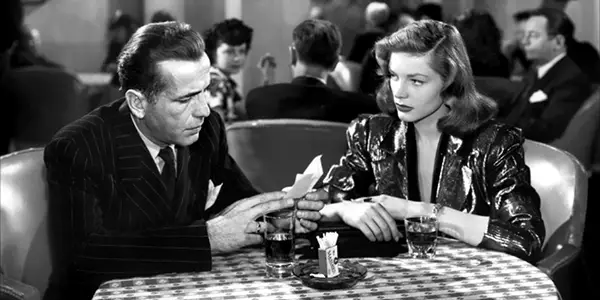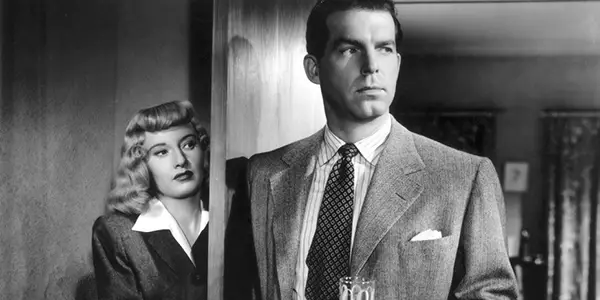Staff Inquiry: Our Favorite Classic Era Noirs

Alex is a film addict, TV aficionado, and book lover.…
Those mysteries, those shadows, and those moods. How is Film Inquiry supposed to resist the Noirvember spirit when the genre is such a delicious treat? To be honest, we didn’t really put up a fight, so this month’s Staff Inquiry is all about gushing over our most beloved examples of film noir.
We limited ourselves to the classical era, which is generally considered to be the ‘40s and ‘50s. That still gave us plenty of options from legendary filmmakers, so as usual our picks exemplify both our personal taste and the broad range that exists within such a sprawling genre.
Darryl A. Armstrong – The Third Man (1949)

“I’m just a hack writer who drinks too much and falls in love with girls,” says pulp fiction writer Holly Martins in The Third Man, one of the most iconic noir films in cinema history.
Everything is askew in The Third Man. The camera angles tilt back and forth, rocking like a Ferris wheel gondola in motion, always vaguely unsettling.
Filmed in post-war Vienna, the city is still half rubble, full of foreigners and black market traders all jostling to gain power and influence over the reconstruction, or, depending on your view, feeding off the already devastated survivors. For every shadow on an alley wall or figure emerging from the fog, The Third Man remains a standout among its genre peers by flipping so many tropes of the typical noir on their head. Martins, played earnestly by Joseph Cotton, is a kind, curious, and self-aware leading man, not the typical hard-boiled gangster or detective, while the damsel in distress would rather be left alone. The crooked scheme is no abstract theft from the rich or violence among thieves, but a real and troubling plot that preys upon the weakest members of the city.
The film doesn’t flinch while exploring the ramifications of greed and grift, but it also manages to humanize the villain without turning him into an anti-hero, except possibly in his own mind. The film benefits from a convergence of excellence, with performances that include Cotton, Alida Valli, and Trevor Howard; a clever and poignant script from author Graham Greene; Orson Welles as actor, dialogue contributor, and icon; and director Carol Reed overseeing the project. The Third Man is a pillar of the noir genre for every rule it breaks as much as every rule it helped establish.
Benjamin Wang – They Live By Night (1948)

The two main characters of They Live By Night are absolutely noir protagonists: morally ambiguous people with haunted pasts for whom we expect a terrible fate. But their romance is so innocent and their desires so simple: they’re a pair of young adults who were raised by criminals, and the film follows their confused, haphazard effort to live like a normal couple.
They Live By Night was the first film by Nicholas Ray, one of the better mid-century Hollywood directors. Like the best of his work, They Live By Night uses deep, detailed settings both to set a tone and to clearly lay out the tasks at hand for the characters. We see, directly, what they build out of their fragmented impression of what normal life is like; we also see how fragile it is.
One highlight: when the two main characters decide to marry, the camera follows them as they walk side by side toward a building that provides services for shotgun marriages. It looks like they’re walking down the aisle. At the same time, the building looks like a normal suburban house; it looks like they’re walking toward a new life, toward domesticity. That part is just a front – inside the house is nothing more than a shady business.
The whole film has an air of tragedy because of little things like this, when the characters’ good intentions are clear but an objective picture of a world full of pitfalls is even clearer. As far as film noirs go, They Live By Night is notably tragic, but it’s also the most romantic film noir I’ve seen.
Emily Wheeler – The Big Sleep (1946)

Like many people, I quickly get lost in The Big Sleep. Literally, I have no clue what happens in this movie. There’s something about gambling and murder and trickery, but it’s all too convoluted to follow. This is actually a common problem for me with film noir because I can never remember names of characters, so if a movie hinges on discussions of who did what when, I guarantee you that I’m confused.
Unlike other noirs, this mystified suspension actually enhances The Big Sleep. Getting bowled over by the quippy dialogue, director Howard Hawks‘ fleet-footed pace, and the flirtation between Humphrey Bogart’s Philip Marlowe and Lauren Bacall’s Vivian Rutledge (or Marlowe and that woman in the bookstore) is what The Big Sleep is all about.
So yeah, it’s less serious than your average film noir, and that’s precisely why I love it. You get the shady dealings and irresistible style, but you also get the impish little wink of Hawks owning up to just how much fun all this luridness is.
David Fontana – Double Indemnity (1944)

If you were to ask me the quintessential film noir, that answer would easily be Double Indemnity. This one has everything – the charioscuro lighting, the star-crossed couple, voice-over, the snappy dialogue, the incessant smoking, the booze. Even looking beyond those fundamental elements of noir for which Double Indemnity easily fits, though, there is even more to love about this film than meets the eye.
Director Billy Wilder, who would go on from here to create numerous beloved films, including another staple noir Sunset Boulevard, here just managed to strike gold relatively early in his career. Bringing together this cast was an unlikely task, as leading man Fred MacMurray, who before this was known primarily for romantic comedies, here comfortably steps into the role, and Barbara Stanwyck, who was reluctant to take the part, turned out to be one of the most seering femme fatales in all of noir.
But the standout for me has always been Edward G. Robinson, mostly known for his gangster performances before this, but here in a more limited role as a claims adjustor, he brings infectious charm. Just watch the one scene where, seemingly in fast-forward and in one take, he describes the many ways in which people commit suicide, and try not to be awestruck.
Double Indemnity is an endlessly rewatchable film. Its dialogue is quick and witty, the acting fully realized, and the mood cast through shadows and minimal lighting becomes all-encompassing. We all know where this is going from the first moment that MacMurray‘s character witnesses Stanwyck wrapped in a towel at the top of her stairs, but the journey to get through is just oh so delightful. Billy Wilder really made one for the ages.
Tynan Yanaga – Laura (1944)

I would say my affection for film noir was love at first sight, and there’s no more exemplary title than Otto Preminger’s bewitching debut, Laura. When French critic Nino Frank began to put a name to this post-war malaise in American crime films, his sample size purportedly included The Maltese Falcon, Murder My Sweet, Double Indemnity, The Woman in The Window, and this picture, among others.
It proves to be one of the finest starting points for the dark genre, but why? We must begin with Gene Tierney, who builds such an aura as the eponymous heroine – a femme fatale without ever trying to be – existing only in the memories of those who knew her. Just as the hardboiled Detective MacPherson (Dana Andrews) is taken with the woman in a portrait, I was quickly enamored with the movie.
The film is stripped down to essentials, mostly character-driven; still, what a menagerie of characters they are, played by Clifton Webb, Judith Anderson, and Vincent Price. The illusory notes of David Raksin’s score are haunting, and Preminger develops his mise-en-scène impeccably, creating engaging visual dynamics between his players and a stylish world around them.
Of course, since this is a mystery I will forego any mention of the plot. However, I will say, in the end, it’s all superfluous. By now, I know Laura perhaps better than columnist Waldo Lydecker, and yet it doesn’t matter because each time the film hits me with a renewed magic. It exists somewhere between the gorgeous, smoky black & white formalism and the obsessive, vice-laden performances. At its finest, film noir gives us a gut-punch of reality. We are often petty, controlling, hedonistic people. Life is often meaningless. Still, we choose to live it anyway because of beauty and love and ultimately hope.
Those are some of our favorite film noirs from the classic era. What are some of yours?
Does content like this matter to you?
Become a Member and support film journalism. Unlock access to all of Film Inquiry`s great articles. Join a community of like-minded readers who are passionate about cinema - get access to our private members Network, give back to independent filmmakers, and more.
Alex is a film addict, TV aficionado, and book lover. He's perfecting his cat dad energy.













